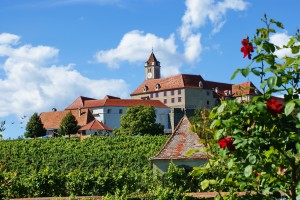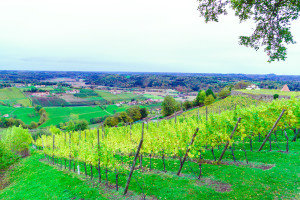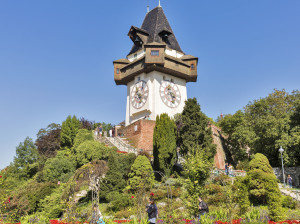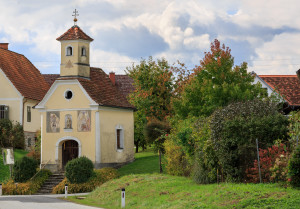
Riegersburg Castle Steiermark
Late last year, the wine world began to hear rumblings of three new Districtus Austriae Controllatus- (DAC-) designated wine-growing regions to be confirmed in the Austrian state of Styria (Steiermark). As of March 3, 2019, we can confirm that these three new DACs— Südsteiermark DAC, Vulkanland Steiermark DAC, and Weststeirmark DAC—have published their Verordnungen (regulations) and are officially in force..
The wines of all three new DAC regions may be produced under the following classifications:
- Gebietswein: Regional wine
- Ortswein: “Village wine” from certain designated villages
- Riedenwein: Single-vineyard wines from classified estates
Read on for a summary of the new regulations concerning these wine regions.

Vineyards surrounding Riegersburg Castle
Südsteiermark DAC: Sauvignon Blanc, the leading grape of the Südsteiermark, is planted in nearly 20% of the region’s vineyards. However, this is a large growing area—currently there are 6,234 acres/2,563 hectares planted to vine; and Riesling, Pinot Gris, and Chardonnay are well-represented as well. The area makes for a stunning landscape, with rolling hills punctuated by staggering slopes—some with an incline as steep as 45°. The soils in the flatter regions are primarily marine sediment, while the hills and slopes contain marl and conglomerate soils. The climate during the growing season tends to warm and humid days combined with cool nights, allowing for a long vegetative cycle and complex, concentrated grapes.
Other details of the Südsteiermark DAC include the following:
- Grapes allowed: Welschriesling, Pinot Blanc, Morillon (Chardonnay), Pinot Gris, Riesling, Muscat, Sauvignon Blanc, and Traminer (Savignin); wine may be single-variety or blends. Grapes must be hand-harvested.
- Required aging: Wines made from Welschriesling grapes may be sold at any time; for all other varieties, the wine may not be sold before March 1 of the year following harvest. Wines designated by a village or single vineyard (Riedenwein) designation may have longer required minimum aging times.
- Wine Styles: Wines are required to be vinified dry and have a stated maximum of 0.4% RS. Wines produced from Riesling or Traminer (Savignin) must display the word “Trocken” (dry) on the label.
- Ortswein: Designated “villages” approved for the production of Ortswein include Kitzeck-Sausal, Eichberg, Leutschach, Gamlitz, and Ehrenhausen.

Uhrtum Clock Tower
Vulkanland Steiermark DAC: As its name implies, Vulkanland Steiermark is rich in volcanic soils often said to help imbue the wines of the region with a distinct character that has been described as “mineral-spice.” The area has 3,765 acres/1,524 ha planted to vines, many of them planted on the slopes of the area’s long-dormant volcanoes, some reaching elevations as high as 1,968 feet/600 meters. The area has a particular affinity for rich, medium-to-full-bodied Sauvignon Blanc, assisted by the warm, dry days and cool, crisp nights typical of the growing season. Klöcher Traminer, known for a rich floral aroma redolent of roses, is sometimes made as a semi-sweet (halbtrocken) wine, and is one of the few wines of the region that may be produced in fully sweet style (labeled as a Prädikatswein).
Other details of the Vulkanland Steiermark DAC include the following:
- Grapes allowed: Welschriesling, Pinot Blanc, Morillon (Chardonnay), Pinot Gris, Riesling, Muscat, Sauvignon Blanc, Traminer (Savignin); wine may be single-variety or blends. Grapes must be hand-harvested.
- Required aging: Wines made from Welschriesling grapes may be sold at any time; for all other varieties, the wine may not be sold before March 1 of the year following harvest. Wines designated by a village or a single vineyard (Riedenwein) designation may have longer required minimum aging times.
- Wine Styles: With a few exceptions (as detailed below), wines are required to be vinified dry and have a stated maximum of 0.4% RS. Wines produced from Riesling or Traminer (Savignin Blanc) must display the word “Trocken” (dry) on the label.
- Ortswein: Designated “villages” approved for the production of Ortswein include Klöch, Straden, St. Peter, Tieschen, St. Anna, Kapfenstein, Riegersburg and Oststeiermark.
- Unique Sweets: Klöcher Traminer, which may be produced in a semi-dry style, or—if labeled as a Prädikatswein—as a sweet wine, may not be sold until April 1 of the year following the harvest.

The Municipality of Puch bei Weiz
Weststeirmark (West Styria) DAC: There are currently about 1,350 acres/546 ha planted to vine and 127 wineries located in Weststeiermark. The terroir of Weststeiermark is described as rolling hills punctuated by steep inclines, many of which house vines at elevations of up to 1,970 feet/600 m. The climate during the growing period is warm and quite humid. The soil of Westeiermark is based on a combination of gneiss and mica-rich schist.
As of the publication of the new Westeiermark DAC, the “Schilcherland DAC” for Schilcher Rosé (approved in October of 2017) is no longer in force—however, the wine continues to be produced as a specialty of the area, labeled as “Schilcher Klassik Westeiermark DAC.” A range of styles of Schilcher Rosé are permitted, include still, frizzante, and fully sparkling.
Other details of the Weststeiermark DAC include the following:
- Grapes allowed: Blauer Wildbacher (Schilcher), Welschriesling, Pinot Blanc, Morillon (Chardonnay), Pinot Gris, Riesling, Muscat, Sauvignon Blanc, and Traminer (Savignin); wine may be single-variety or blends. Grapes must be hand-harvested.
- Required aging: Wines produced from Welschriesling and Blauer Wildbacher (Schilcher) grapes may be sold at any time; for all other varieties, the wine may not be sold before March 1 of the year following harvest. Wines designated by a village or single vineyard (Riedenwein) designation may have longer required minimum aging times.
- Wine Styles: Wines are required to be vinified dry and have a stated maximum of 0.4% RS. Wines produced from Riesling or Traminer (Savignin Blanc) must display the word “Trocken” (dry) on the label.
- Ortswein: Designated “villages” approved for the production of Ortswein include Ligist, Stainz, Deutschlandsberg, and Eibiswald.
References/for more information:
- DAC Regulations – Südsteiermark
- DAC Regulations – Vulkanland Steiermark
- DAC Regulations – Weststeiermark
- https://www.austrianwine.com/our-wine/wine-growing-regions/steiermark-styria/schilcherland/
- https://www.austrianwine.com/our-wine/strategy-for-origin-marketing/dac-districtus-austriae-controllatus/dac-regions/vulkanland-steiermark-dac/
- https://www.austrianwine.com/our-wine/strategy-for-origin-marketing/dac-districtus-austriae-controllatus/dac-regions/suedsteiermark-dac/
Post authored by Jane A. Nickles, your blog administrator…